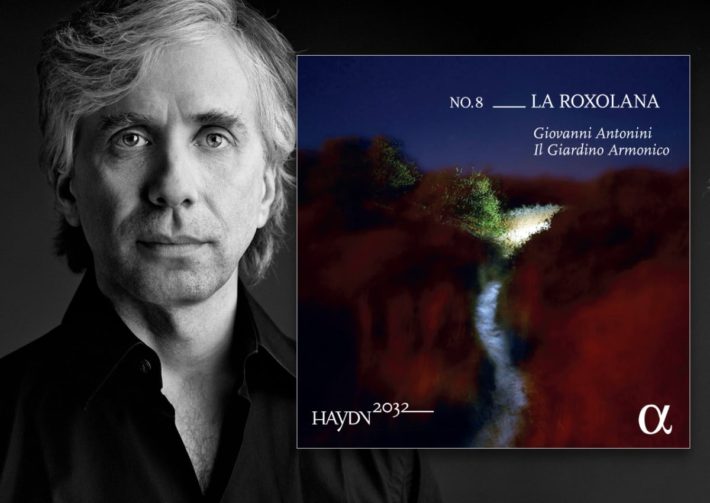Image: Paolo Morello
This is the eighth release in the Haydn 2032 Project, which will eventually include recordings of Haydn’s entire symphonic oeuvre conducted by Giovanni Antonini. The last three volumes featured the wonderful Basel Chamber Orchestra, but this newest recording brings a welcome return of Antonini’s Il Giardino Armonico, who perform on the first four volumes.
Like previous albums, this volume is centers around a theme, allowing Antonini to examine the Haydn Symphonies’ relationships with themselves and with other composers. This time around, the opening Symphony, No. 63 (“La Roxolana”) is used to observe Haydn’s treatment to “other music”, whether it’s popular or what he considered as “oriental”. Antonini himself deals with this “crossover” in the interesting booklet, and the regularly accompanying article by Christian Moritz-Bauer delves into it further.
The playing of Il Giardino Armonico is well-nigh faultless, with pinpoint precision in both intonation and rhythm and particularly engaging wind playing. Listening to these same symphonies in performances from Hogwood’s aborted 1990s cycle with the Academy of Ancient Music, it is readily apparent how much performance on period instruments has improved in the last twenty-five years. And Hogwood’s interpretations now seem somewhat staid and anonymous when compared to these new passionate and individual readings.
Consider both performances of Symphony No. 43 “Mercury.” Hogwood’s first movement takes 10’24” versus Antonini’s 9’49”. While the timings are not far apart, the performances could hardly be more different. The playing of Il Giardino Armonico immediately draws the listener in, with supple shaping of phrases, playful banter between winds and strings, slashing sforzando chords, and a propulsive forward momentum. In comparison, Hogwood and his players sound distinctly pedestrian. In the second movement, the sounds of Il Giardino Armonico’s strings is sensuousness and sweet, whereas the playing of the Academy of Ancient Music is astringent and colorless. And Hogwood’s tempo is simply too slow (11’34”), whereas Antonini’s performance, almost three minutes faster, seems just right. Nothing seems rushed, but the slightly faster tempo finds a playfulness in Haydn’s writing that fails to register in Hogwood’s reading.
Related Classical Music Reviews
- Review: Haydn – Complete Symphonies (Vol 7 – No. 9, 65, 67) – Antonini
- Review: “All Shall Not Die” – Haydn String Quartets – Quatuor Hanson
- Review – Beethoven – Symphony No. 9 – Antonini, Kammerorchester Basel
Speed is again an issue in the third movement, Hogwood’s chosen tempo weighing the music down, while Antonini’s faster pace sets the foot-tapping, creating an almost boisterous mood. The difficult-to-find Pinnock/English Consort recording (worth tracking down) is also slower, but Pinnock and his players ensure the music is buoyant and dance-like. The difference is that Pinnock’s reading is elegant and regal, whereas Antonini’s is earthier, like a peasant folk dance. Both interpretations are convincing. It is worth noting that while Hogwood and Pinnock follow all the repeats at the return of the Minuet, Antonini does not.
The fourth movement (and indeed, all three of the final movements on this new recording) suggests that Antonini’s interpretations are deepening as the cycle progresses. In earlier volumes, he sometimes adopts overly fast tempi that seem intent on displaying the virtuosity of his players over the intended effect of the music. But in this latest recording, I sense a more thoughtful approach to the fast music, a subtle relaxation that allows the players of Il Giardino Armonico to more fully relish Haydn’s writing.
As mentioned, each of the previous volumes in this series feature works by other composers, usually drawn from Haydn’s contemporaries. This newest release breaks that pattern by including a performance of Bartok’s Romanian Dances – a first for period strings! And the performance is surprisingly successful, in large part because Antonini encourages his players to use an urgent, extrovert style of playing that successfully draws out the connection to folksong. Listening again to Solti’s performance of these dances with the Chicago Symphony Orchestra, I was shocked to realize that his interpretation is altogether gentler and more refined than this new performance. Antonini offers another surprise by playing a Renaissance transverse flute in two of the dances – again, the timbre and style are very convincing, and while I am not sure I see the connection with Haydn’s music as clearly as Antonini and the producers intend, I very much enjoyed hearing Bartok’s music played by this musicians.
So, another excellent volume in a series that promises to be a new landmark in Haydn symphony cycles. We can only hope that Alpha remains committed to recording all 106 symphonies and does not give up on this project as Decca for Hogwood and Hyperion for Goodman. The recording is excellent, warm and spacious. Volume 9 is anxiously awaited.

Haydn 2032, Vol. 8 – “La Roxolana”
Haydn – Symphonies No. 28, 43 (“Mercury”) and 63 (“La Roxolana”)
Bartok: Romanian Folk Dances
Anonymous: Sonata Jucunda
Il Giardino Armonico
Giovanni Antonini – Conductor
Alpha Classics, CD Alpha 682
Haydn Symphonies – Recommended Comparisons
Read more classical music reviews or visit The Classic Review Amazon store
Follow Us and Comment:
[wd_hustle id=”HustlePostEmbed” type=”embedded”]











